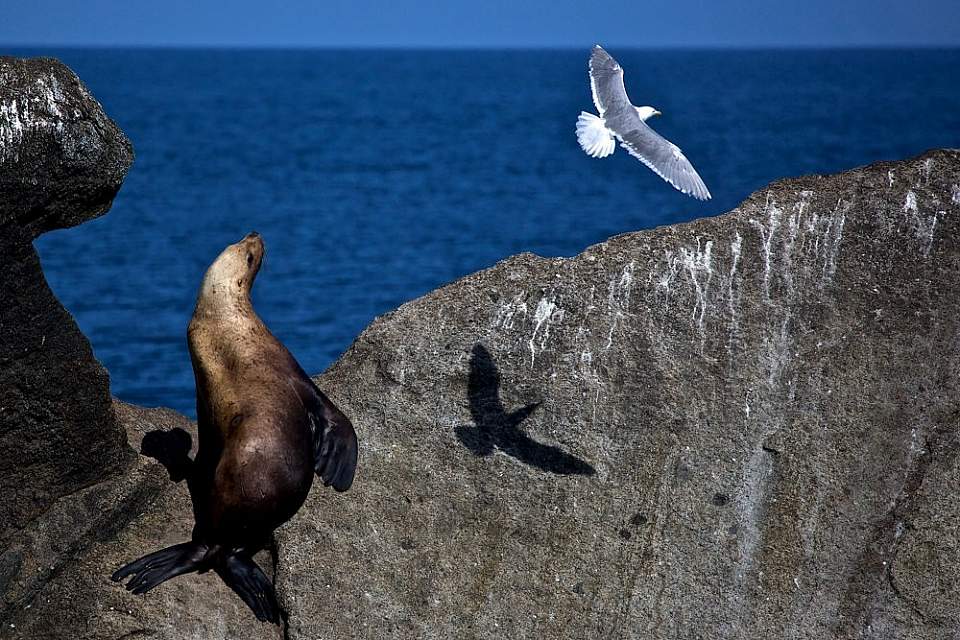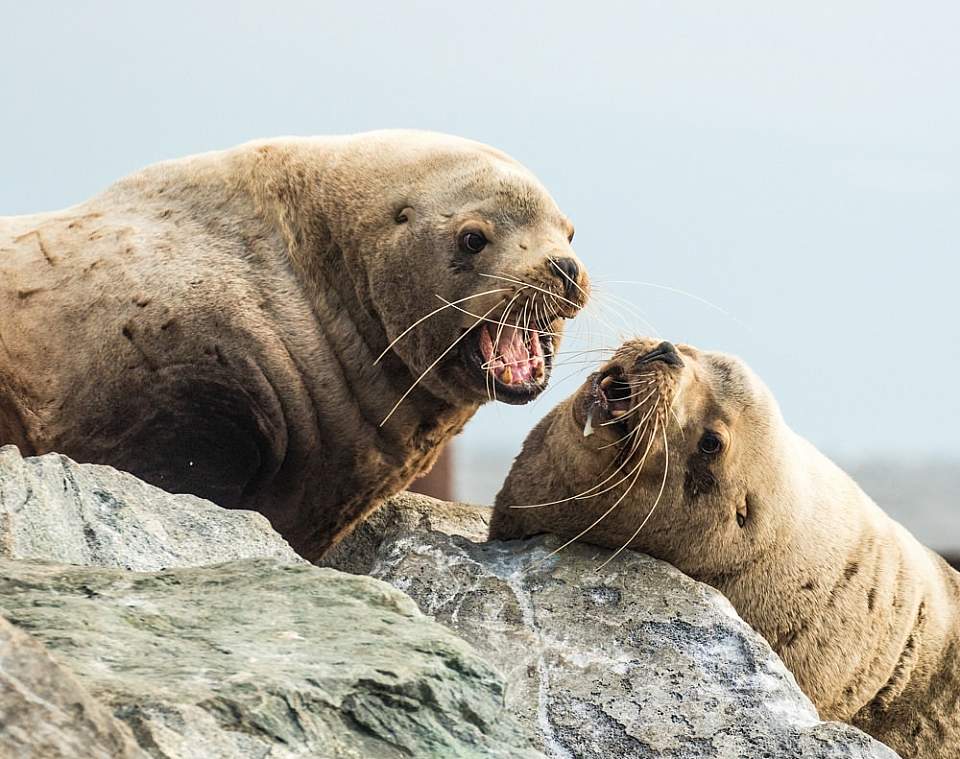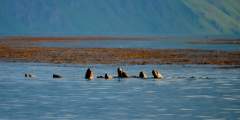Alaska Steller Sea Lion Haulouts
As large and toothy as brown bears, Steller sea lions are gregarious and highly intelligent marine mammals—the largest member of the “eared seal” family that includes other sea lions and fur seals. They prowl the ocean off Alaska’s coast in pursuit of salmon and other fish, from the Southeast archipelago through Southcentral waters to the tip of the Aleutian Chain and beyond. They are often seen from the shore or on marine tours out of Whittier, Seward, Valdez and Southeast towns like Juneau. Large congregations regularly haul out on nearly 500 sites—often remote capes and rocky peninsulas—spread throughout their range.
Jump To: MAP | Kenai Fjords National Park | Southeast, Alaska and Glacier Bay National Park | Prince William Sound | Fishing Ports | Guaranteed Viewing | Viewing Tips | All Locations
Popular Spots

Board a day cruise to see sea lions in their natural habitat
Kenai Fjords National Park and Resurrection Bay
For best viewing, take a marine tour boat out of Seward
Steller sea lions love the waters of Resurrection Bay and lone animals can frequently be seen swimming or foraging offshore from the coastal park in downtown Seward and other locations. But for the most intense and exhilarating sea lion viewing, there’s nothing like what you’ll experience on a marine tour that visits one of the bay’s many haul-outs. From early spring through mid-summer, sea lions gather at the entrance to Mary’s Bay on Rugged Island and the south face of Hive Island, both near the eastern entrance. To the west—inside the national park—sea lions can be found on the ocean side of No Name Island (one of the most common tour destinations) as well islets and knobs in the vicinity of Cape Aialik. The Chiswell Islands—10 miles south on the edge of the deep ocean—hosts the area’s major rookery, often the focus of scientific investigations.
Southeast Alaska and Glacier Bay National Park
For best viewing, take a marine tour boat
Steller sea lions are found throughout the inland seas surrounding Alaska’s rain forest archipelago as well as the newest glacial fiords inside the national park. This eastern population is considered stable and growing by scientists, and it’s a regular occurrence to spy the big brown “sea bears” swimming in the channels and passages while on shore in Gustavus, Juneau, Sitka and Ketchikan. But for the most satisfying experience and a very good chance to see sea lions gathered together on a rocky haul-out, you should take one of the many marine wildlife tours. Guides in every Southeast community report seeing sea lions during almost every excursion. These tours are focused on all marine wildlife (some operators guarantee money back if you don’t spy a whale) so you may also see seals, sea otters, Dall’s porpoises, seabirds, bald eagles, humpbacks and more.

See several sea lion haulouts in Prince William Sound
Prince William Sound
Take water taxi charters or marine tours from Whittier and Valdez
Although the Sound’s Steller sea lions are part of the endangered western population, people on cruises or out sea kayaking regularly see both lone animals and groups hauled out on islets. It’s not uncommon to spy a sea lion or two swimming in Passage Canal near Whittier. But your best bet will be a marine wildlife tour out of Whittier or Valdez. Several major haulouts attract sea lions in the Western Sound, especially two locations on the northeast arms of Perry Island. In the Eastern sound, sea lions are often hauled out in the vicinity of Glacier Island in the mouth of the new fiord formed by the retreat of the Columbia Glacier.
Guaranteed Viewing
Alaska Sealife Center
In Seward, Mile 0 of Seward Highway, south end of 3rd Avenue
This very popular public aquarium and research center on the shore of Resurrection Bay maintains a multistory habitat for its resident Steller sea lions, often with a one-ton male swimming in one tank and smaller females in another. The experience of standing before ceiling-high plate glass and watching animals as massive as brown bears glide and roll underwater with sweeping elegance will boggle your mind. These animals are typically born in captivity and trained from birth so scientists can safely examine them during ongoing studies.
Depending upon funding, the Alaska SeaLife Center sometimes maintains a live feed from a haul-out on Chiswell Island, about 10 miles south of Seward in the mouth of Resurrection Bay.
General Advice:
- You’re out enjoying Alaska’s waters—perhaps kayaking, boating, or fishing—and you see some Steller sea lions. Naturally, you want to get a closer look at these amazing creatures. But there’s a right way and a wrong way. All of Alaska’s major Steller sea lion haulouts and rookeries are protected. Approaching a sea lion resting on land is prohibited under federal law and can be dangerous.Here are the principles to follow when viewing.
- Take a marine wildlife tour. Operators often cruise past one of the estimated 470 sea lion haul-outs documented along the North Pacific Rim. The sight of a rocky headland packed with these “sea bears”—enormous bulls and harems of smaller cows (some with nursing pups)—is one of Alaska’s most extraordinary wildlife spectacles.
- Sea lions will often “porpoise” when they swim away—plunging head first with back rising as they dive. This distinctive motion distinguishes them from seals, which tend to sink straight down like a periscope before swimming away.
- Lone animals out foraging will sometimes make a wake and dramatically disturb the water. If nearby, listen for their “blow”—a loud exhalation reminiscent of a whale taking a breath.
- Take the Lead, Do not Feed! Feeding sea lions is illegal—and for a good reason. When humans feed them, sea lions lose their natural wariness of people and associate them with food. Feeding them changes their natural behavior, decreasing their willingness to find their own food and increasing the chance they’ll steal fish (and gear) from fishermen (who can and have been injured as a result). These behavioral changes may even be passed to other sea lions. The result is an increased risk of injury from boats, entanglement in fishing gear, and intentional harm by people frustrated with the behavioral changes.

Steller Sea Lion and it's pup
For More Information:
- Steller sea lion PDF from Alaska Wildlife Notebook
- A Steller sea lion primer from game biologists
- Steller sea lion status and scientific research from NOAA Fisheries
- Hope for a troubled status. A steep population decline between the 1960s and 1990s led to the species’ listing under the federal Endangered Species Act. As of 2018, the western population of sea lions—from Prince William Sound through the Aleutian Chain—numbered an estimated 54,000 animals and remains listed as endangered. Still, sea lions appear to be increasing in number in the eastern and central Gulf of Alaska areas where Southcentral Alaska marine tours take place. The eastern population—from Cape Suckling through Southeast and British Columbia—is considered stable and slowly rising with more than 40,000 animals. This population was removed from the ESA list in 2013.
Show Map
Points of Interest
Seward
In the water, there is a triangularly shaped large rock with a smaller triangular rock in the water to its right. Atop this smaller rock we hope to find a group of the Steller sea lions. If we do not spot them here, they will be a little further south on the beach. Look for various sizes and colors of animals. Dark grey animals have just left the water, brown or tan animals have been out a while and are dryer. Fully grown males have a very… ...more
Juneau
From the boat ramp parking lot, walk along the driveway to Senator Gruening’s home. The path ends where Peterson creek cascades down into Lynn Canal. It’s an amazing place for wildlife viewing when the salmon are running.
Glacier Bay National Park
Humpback whales, sea otters and harbor seals are scattered throughout the Beardslees, with whales and otters most likely to be seen on the western side of the islands — nearest to open water. Watch the shore for black bears and moose. Black oystercatchers – black shorebirds with bright red-orange bills – nest on the islands. Look for harlequin ducks, pigeon guillemots, pelagic cormorants, arctic terns, marbled murrelets and large flocks of ...more
Kodiak
This rocky, mountainous and remote island is Alaska’s best place for observing and photographing Pacific walruses as they rest on the rocky shorelines in the hundreds or even thousands during summer. Visiting is only for the adventuresome as it involves travel in small planes and boats, and overnight stays on the island involve camping in a remote setting; but for those willing, it is an unparalleled wildlife and wilderness experience.
Unalaska
Jutting half a mile into the center of Unalaska Bay, the Dutch Harbor Spit offers a short, sea-level hike for all ages, with beach access, wildlife viewing and birding. The trail follows an old roadbed, which makes for an ideal hiking surface. You’ll want to stop frequently with a ready camera for close-up views of marine mammals on either side of the spit.



